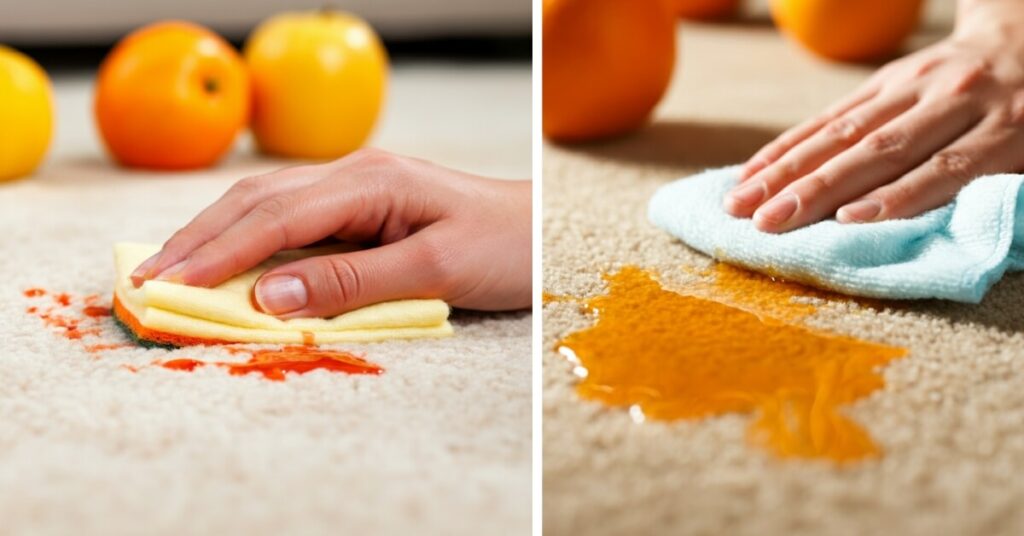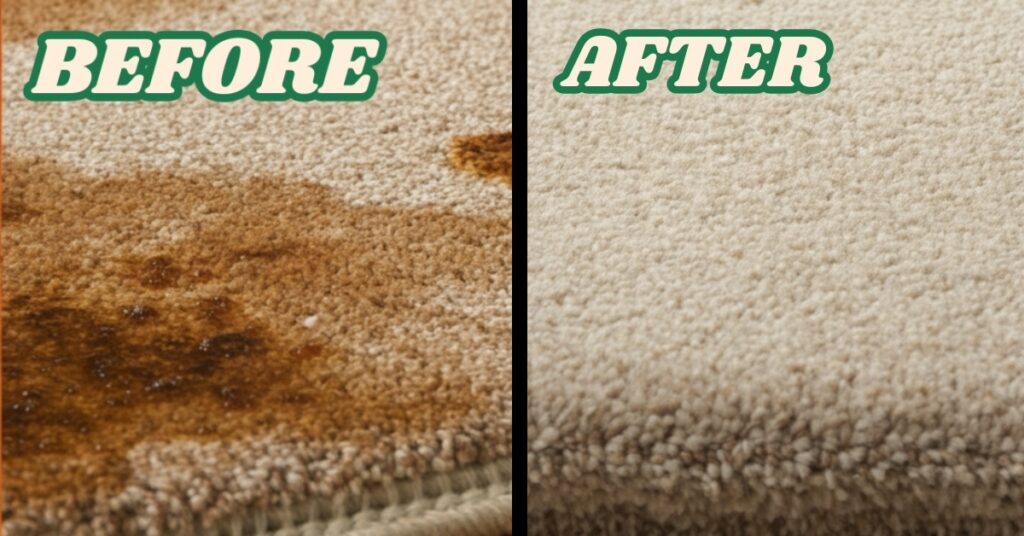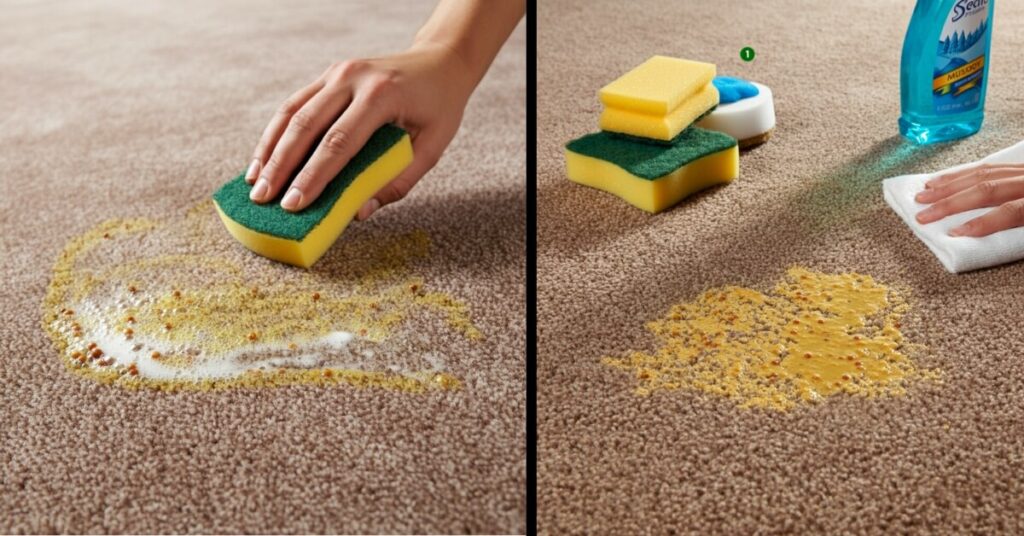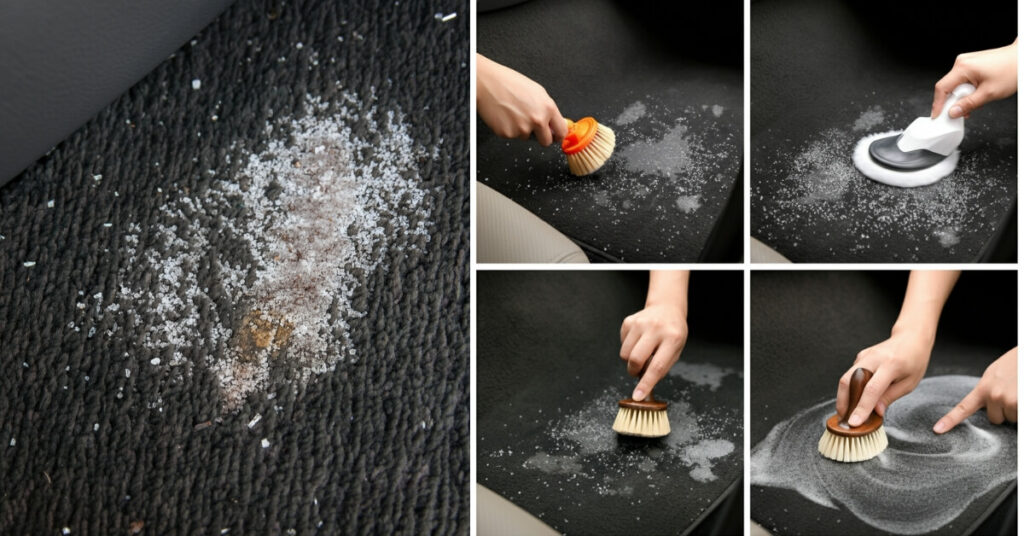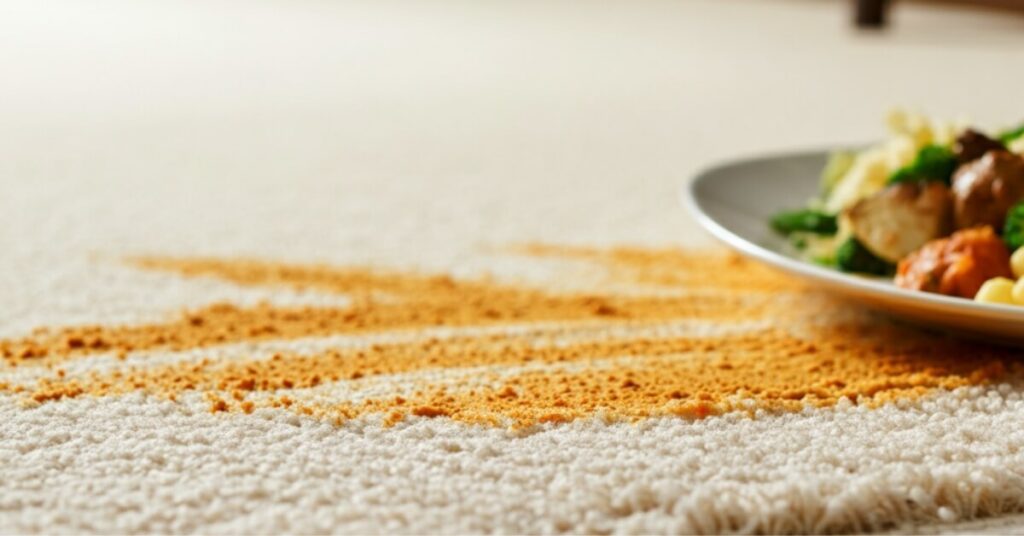As an Amazon Associate, I earn from qualifying purchases.
If you have carpeted floors, spills can be a real hassle—especially when you’re trying to figure out how to get fruit juice stains out of carpet. The vivid, sugary juice drinks can wreak havoc on your flooring if not addressed quickly. Their natural dyes seep deep into carpet fibers, and the sugar content makes them even more stubborn to remove.
As many families know, juice spills are a part of daily life, especially in households with children or during gatherings. Because juice stains can seem impossible to eliminate, knowing how to remove them fully becomes very important in any household.This guide will help you remove fruit juice stains from the carpet. Whether you have freshly spilled orange juice or a long-forgotten grape juice stain buried below a rug, the right techniques can work wonders.
Contents Overview
What Makes Juice Stains Difficult to Remove?
Fruit juices are not just harmless drinks; they are hidden trouble stains! If you know how to deal with these messes, it becomes very easy to eliminate tough stains with effective solutions.
Natural Pigments
Juice stains consist of natural pigments, anthocyanins, and carotenoids. Powerful dyes regions with intense pigmentation contain brightly colored grapefruits, cherries, pomegranates, and cranberries.
The harder it is to remove juice, the more vivid the color. Like artificial dye, these pigments are incredibly difficult to remove. If you do not fully take these pigments out of the carpet, they can reappear, especially after drying.
Sugar Content
Fruit juices have a high sugar concentration. This stickiness attracts dirt and dust over time, which causes stains to bloom or darken beyond the original spill. If left uncleaned for a long time, the sugar residue can act as a sort of glue, locking the color into the carpet fibers.
Quick Absorption
Due to the absorbent nature of most carpet fibers, juice can seep into thick or plush carpets quickly. Even a few seconds’ delay can allow the stain to burrow deep into the padding. If you don’t act quickly, you may have to deal with juice that goes beyond the surface level of the carpet.
Heat and Sunlight
Direct sunlight or heat (like hot rooms or sunny windows) can cause the stain to “bake” into the fabric. With such conditions, fruit juice spills become a race against time, making fast action very rewarding.
Knowing these factors will assist you in using the right tools and methods to remove juice stains for good.
How to Remove Fruit Juice Stains from Your Carpet (Step-by-Step)
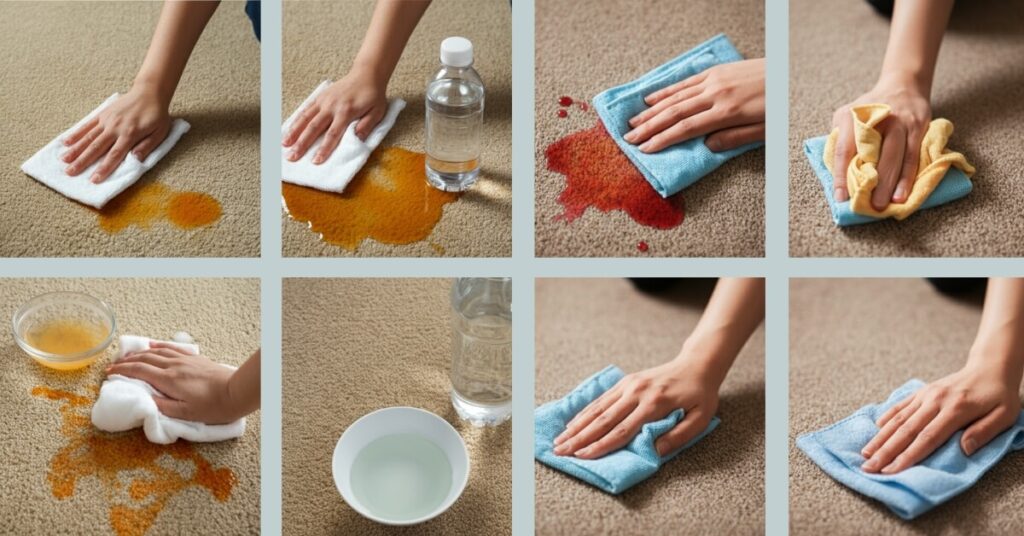
Worrying won’t help when you spill fruit juice—your carpet can be saved with quick action using these steps. For best results, odor-free carpets and a thorough clean, follow these methods step by step.
Step 1: Blot Gently
Remember to undertake the spill reaction by blotting the area first with a clean, absorbent cloth or paper towel. Stains should never be rubbed. You can start from the edge and slowly move inwards to form small circles.
Gentle capture and release squeeze methods should be employed while soaking up the juice so as not to push the spill deeper into the fibers. For significant spills, switch to fresh towels and repeat the soak and switch till no juice is soaked up. In case of sticky spills, continue blotting till the towel comes up damp and clean, not stained.
Applying a stack of several paper towels after soaking them in water and pressing down for thirty seconds makes them even more absorbent. For thick carpet, standing while wearing clean socks or feet helps the paper towels to absorb even more liquid.
Step 2: Prepare Soap Solution
Preparing a simple cleaning mixture with one tablespoon of mild dish soap and two cups of warm water (not hot) works well. Using a gentle soap prevents residue buildup that attracts dirt and grime later. Stir until fully dissolved. Remember, do not use excessive soap, as this will create a hard rinse and may leave sticky residue behind.
Another option is pouring the solution into a clean spray bottle. This helps mist the area more evenly, which is useful for large or oddly shaped stains. Harsh detergents, bleach, or colored soaps should not be used as these can set stains or cause discoloration.
Step 3: Work On The Stained Area
Soak a clean white cloth with a mild soap solution, then wring it out to prevent soaking the carpet. Blot the stained area on the carpet with the cloth, working from outside the stain towards the center. Gently press and allow the soapy water to saturate the stain, helping to break the sugar and dye bonds. Blot for several minutes, refreshing the cloth as more juice is absorbed.
To treat persistent old stains, it is best to let the solution sit for 5-10 minutes before blotting, which helps break down the stubborn pigments. For the larger, stubborn stains, it would be easier to apply the solution using a spray bottle. Blot your stain again after the treatment.
If the stain appears really dark, you can try to work the fibers loose with your fingers or a very soft bristle brush in gentle, circular motions. Always finish with drying blotting so you do not rub the stain into the carpet and deepen it.
Step 4: Blot Again with Dry Towel.
Use a dry towel to pat the area after applying the soap solution to lift out the moisture and stain. Dry towels or cloths will absorb the soap solution, so it is best to pat the area dry gently.
Blotting excess moisture is very important as it helps prevent the formation of water marks. Also, ensure that the stain and soap are being genuinely lifted out instead of being spread around. If your towel becomes wet, then replacing it and repeating the process is recommended. If the towel is absorbing some color, it means the stain is fading.
Step 5: Use Vinegar Cleaning Solutions If Required
If any color is left behind during the first wash, it’s time to move on to a vinegar solution. Mix one part white vinegar with two parts warm water in a spray bottle. Vinegar works best when it comes to breaking down tougher fruit pigments as well as neutralizing sticky sugar residues and lingering odors.
Lightly spray the affected area and blot immediately with a clean towel. Rinse and wring your cloth during blotting so that you lift residue instead of reapplying it. For stubborn bright cherry or grape juice stains, a second or third treatment with vinegar might be required. You might notice a slight vinegar odor, but as it dries, the faint vinegar smell dissipates, taking the odor with it. When properly diluted, vinegar is safe for most carpets, making it a great household cleaning staple.
Step 6: Blot Dry after Rinsing with Water
Using a clean cloth dampened with cool water, rinse the area with soap and sticky residue. Blot repeatedly until all traces of soap and vinegar are removed. Failing to rinse can lead to sticky patches that attract dirt.
Continue drying the area by using another towel to blot it until it feels dry to the touch. To dry thicker carpets, try putting both hands on a towel and pressing down. Better yet, stand on the towel to pull out extra moisture. If there are pets or toddlers in the house, it’s ideal to rinse after cleaning at least two times to ensure no cleaning residue is left behind.
Step 7: Weight Drying Technique for Moisture Control
Place a clean, absorbent towel over the wet area, then cover it with something heavy like books or a board to hold gentle pressure. Leave it for at least an hour. This technique absorbs excess moisture that can lead to musty odors and mildew. Moreover, this keeps the carpet fluffy instead of matted where cleaning took place.
For high-pile carpets, it may be helpful to replace the first towel after 30 minutes. Along with removing excess moisture, the more thorough the drying, the less risk of mold, while keeping the house odor-free. You can read our article how to dry carpet after cleaning to have a proper drying guideline.
DIY Stain Removal Mixes
Dish Soap + Vinegar Solution
Add 1 tbsp of dish soap and 1 tbsp of white vinegar into a bowl, then pour in warm water. Add the mixture into a spray bottle and use as needed for stains. Best For: Easing apple juice, mildly colored juice spills, and post-treatment stains that were previously treated with commercial stain removers.
Lemon Juice (For Light Carpet)
Lemon juice can be effective against orange or yellow stains on white carpet. Its natural acidity works to cut those stains out. Always test in a hidden spot. Apply juice to the stain, wait 5–10 minutes, and then blot it. It cannot be used on dark or colored carpets as it can bleach.
Hydrogen Peroxide (For Very Old Stains)
Combine one tablespoon of hydrogen peroxide with three parts water. Use a cotton swab or cloth to carefully treat persistent aged stains. Peroxide can lighten carpet color, so always rinse well and test first.
What to Avoid:
Products that contain bleach should never be used to clean fruit juice stains. These will ruin your carpet permanently by discoloring it, leaving a harsh chemical smell, and weakening the carpet fibers, especially synthetic blends.
Expert Tip:
For a speedy response to new juice spills, keep a blended solution of dish soap and vinegar ready. Also, keep a box of baking soda for deodorizing after rinsing. To remove damp carpet odors, sprinkle baking soda, let sit for an hour, then vacuum.
Ways To Avoid Juice Stains On The Carpet
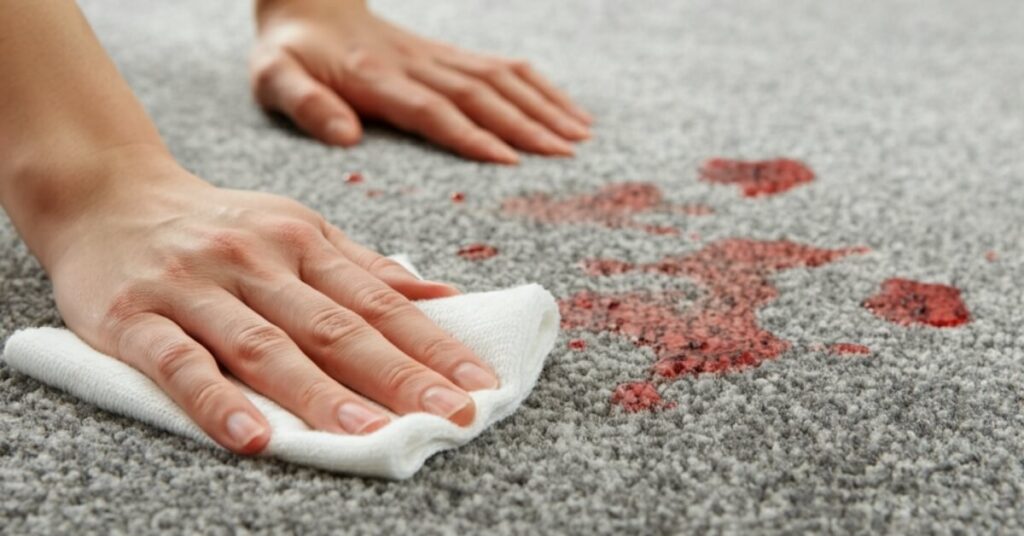
Smart Preventative Measures
Nestle’s juice boxes filled with juice can quickly lead to a state of madness. To avoid such juice-stained mayhem, make the routine after-meal cleaning a family affair. As a parent, soak a piece of cotton with the cleaning solution and gently tap it to reveal a fresh, spotlessly clean carpet free from grime.
Household Items, such as handy Oxi-stain remover patches, scrubbable mats, or easily cleaned rugs, can save hours when it comes to dishwashing. You can always expand the protected carpet area with these easy-to-use items.
Restricting juice to the kitchen while providing an easy-access zone filled with laminate or vinyl tiles helps a family avoid repeated juice disasters and deal with allergies. In the end, always be prepared and stocked up for a quick clean, and keep them accessible in a first aid box, which helps erase simmering stains.
FAQs
What is the best cleaner for fruit juice stains?
OxiClean Carpet Stain Remover and Resolve Carpet Cleaner do a good job of removing juice stains, and Bissell Enzyme Cleaner excels with sticky and organic stains, particularly when children or pets are present in the house. For those who want to create their own products, a mixture of dish soap and vinegar works for most spills encountered in a day.
Will white vinegar discolor my carpet?
No, for most carpets white vinegar is safe when diluted (one part vinegar to two or three parts water). Do a spot test on a less visible area first to make sure there is no reaction or discoloration.
Can old fruit juice stains be removed?
Yes, old stains can be removed, but multiple rounds may be necessary. Stubborn, dried, or heat-set stains respond especially well to enzyme-based cleaners and diluted hydrogen peroxide. Remember to treat the stain with patience and time.
Are natural juice stains worse than artificial ones?
Natural juices tend to stain more because of concentrated pigments and natural dyes. Some synthetic juices, although bright and colorful, may be more easily cleaned out.
Is baking soda effective in getting rid of juice stains?
After the cleaning process, baking soda works best to eliminate residual moisture and neutralize any stale smells. For best results, sprinkle on the area after it dries, let it sit, and vacuum. Just remember, it cannot work as your main stain remover.
Conclusion
With the right techniques and thorough cleaning methods, your carpet can be juice-stain free. Don’t let fruit juice stains ruin your day. Smart product choices and preventive measures will enable you to address repairs promptly after spills occur.
Restoring your carpet will be a breeze! There are many options, ranging from gentle DIY solutions, like dish soap and vinegar, to specialized commercial products like OxiClean, and every cleaning budget has an option for every type of juice mishap.
Always remember that prevention is key. Spill-proof bottles, swift clean-up routines, and well-placed rugs can greatly help protect your flooring investment. For those rare moments when a carpet stain seems to defy your best efforts, don’t hesitate to contact professional cleaners or rent a carpet steamer for deep-cleaning magic.
As an Amazon Associate, I earn from qualifying purchases.
